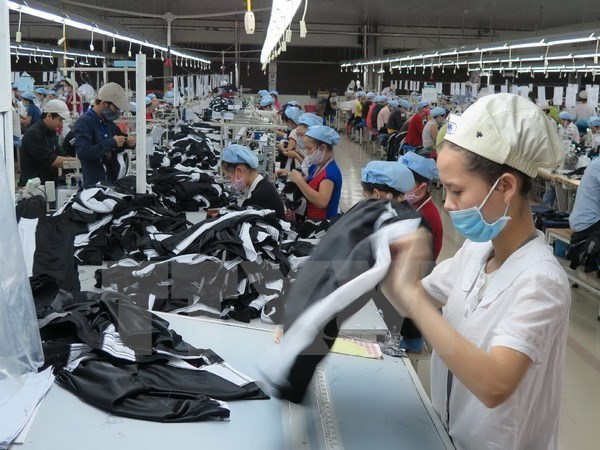
Vietnam has shipped footwear products to nearly 100 countries worldwide, with 72 of them buying at least 1 million USD of the products, reported the Vietnam Leather and Footwear Association (LEFASO).

Workers make cloths for export
at a factory in Vietnam (Photo: VNA)
Statistics from the General Department of Customs showed that the US remained
Vietnam’s largest footwear importer as of late May with 1.99 billion USD, up
13.9 percent year-on-year and accounting for 35.2 percent of Vietnam’s total
footwear export value.
The European Union (EU) ranked second with 1.76 billion USD, up 9.7 percent
annually and making up 31.15 percent of the total. It was followed by China
(418.4 million USD), Japan (284.4 million USD), the Republic of Korea (RoK)
(158.3 million USD). Those five markets accounted for 83.3 percent of Vietnam’s
earnings from footwear export.
The US also took the lead in buying Vietnam’s handbags, suitcases and
briefcases, spending in excess of 555 million USD, up 6 percent and making up
41.1 percent of Vietnam’s shipments of those products. Behind the US was the EU
(365 million USD), Japan (146.5 million USD), China (57.6 million USD), the RoK
(52.8 million USD). The five top markets accounted for 87.2 percent of the
total export value of handbags, suitcases and briefcases of Vietnam.
Nearly 80 percent of Vietnam’s leather product and footwear export value comes
from factories located in the south, the southeast and the southwest regions.
Ho Chi Minh City and the southern provinces of Binh Duong and Dong Nai are
currently the largest footwear and handbag producers.
In the north, most leather and footwear factories are concentrated in Thanh
Hoa, Hai Phong, Hai Duong, Hanoi, Ninh Binh and Thai Binh. In the central
region, only Da Nang city and Quang Nam province have some large-scale
production facilities.
In the first half of the year, the leather and footwear sector earned 8.7
billion USD from exports, marking a 11 percent increase, including 7 billion
USD from footwear and 1.65 billion USD from handbags and suitcases, up 12
percent and 4 percent, respectively.
It is forecast that the total earning this year will hit 17.8 billion USD, up
10 percent annually.
The LEFASO suggested that firms join manufacturing chains at home, in the
region and the world while adopting advanced technologies and exploiting
advantages offered by free trade agreements in which Vietnam is a member.
Source: VNA
After more than four years of implementing a project launched by the Hoa Binh Party Committee’s Standing Board on developing agriculture and promoting product consumption linked with building new-style rural areas for the 2021-2025 period, the province’s industry and trade sector has made significant strides, greatly contributing to local socio-economic development.
Luong Son district has identified 2025 as the year for the accelerated breakthrough to successfully implement the socio-economic development plan for the 5-year period from 2021 to 2025. The district has been focusing on executing the plans and trying to achieve a GRDP growth rate of approximately 15%.
Since the beginning of this year, under the direction of the Department of Agriculture and Environment, the Sub-Department of Agricultural, Forestry, and Fishery Product Quality Management has strengthened the integration of the professional activities to promote and guide the organizations and individuals in the production and trading of agricultural, forestry, and fishery products to comply with the legal regulations regarding the use of chemicals, pesticides and veterinary medicines in crop cultivation, livestock farming and aquaculture. They also provide guidance to processing and manufacturing establishments on keeping the records to trace the product origins and using food additives from the approved list according to the regulations.
Hoa Binh province saw a significant rise in state budget revenue in the first two months of 2025, heard a meeting chaired by Vice Chairman of the provincial People’s Committee Quach Tat Liem.
Ha Thi Ha Chi, a 26-year-old graduate in law, has taken an unconventional path by returning to her hometown in Mai Chau district to establish the Tong Dau Cooperative, creating stable jobs for local women and bringing Thai ethnic brocade weaving to the global market.
As the Lunar New Year 2025 approached, pork prices surged, creating a profitable season for farmers in Tan Vinh commune, Luong Son district. Taking advantage of the rising demand, Can Minh Son, a farmer from Coi hamlet, sold over 30 pigs at 69,000 VND/kg, each weighing more than 100 kg. After deducting expenses, his family earned a profit of over 50 million VND.



